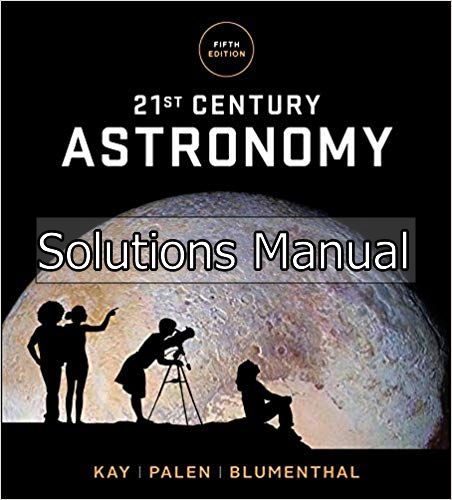21st Century Astronomy 5th Edition Kay Solutions Manual
You may also like
-
$26.50
$50.00 -
$26.50
$50.00
21st Century Astronomy 5th Edition Kay Solutions Manual

Product details:
- ISBN-10 : 0393603326
- ISBN-13 : 978-0393603323
- Author: Laura Kay
Influenced by astronomy education research, 21st Century Astronomy offers a complete pedagogical and media package that facilitates learning by doing, while the new one-column design makes the Fifth Edition the most accessible introductory text available today.
Table contents:
- Chapter 1: Thinking Like an Astronomer
- 1.1 Earth Occupies a Small Place in the Universe
- 1.2 Science Is a Way of Viewing the Universe
- 1.3 Astronomers Use Mathematics to Find Patterns
- Origins: An Introduction
- Summary
- Exploration: The Scale of the Universe
- Chapter 2: Patterns in the Sky—Motions of Earth and the Moon
- 2.1 Earth Spins on Its Axis
- 2.2 Revolution about the Sun Leads to Changes during the Year
- 2.3 The Moon’s Appearance Changes as It Orbits Earth
- 2.4 Calendars Are Based on the Day, Month, and Year
- 2.5 Eclipses Result from the Alignment of Earth, the Moon, and the Sun
- Origins: The Obliquity of Earth
- Summary
- Exploration: Phases of the Moon
- Chapter 3: Motion of Astronomical Bodies
- 3.1 The Motions of Planets in the Sky
- 3.2 Kepler’s Laws Describe Planetary Motion
- 3.3 Galileo’s Observations Supported the Heliocentric Model
- 3.4 Newton’s Three Laws Help Explain How Celestial Bodies Move
- Origins: Planets and Orbits
- Summary
- Exploration: Kepler’s Laws
- Chapter 4: Gravity
- 4.1 Gravity Is an Attractive Force between Objects
- 4.2 An Orbit Is One Body “Falling Around” Another
- 4.3 Tidal Forces Are Caused by Gravity
- 4.4 Tidal Forces Affect Solid Bodies
- Origins: Tidal Forces and Life
- Summary
- Exploration: Newton’s Laws
- Chapter 5: Light
- 5.1 Light Brings Us the News of the Universe
- 5.2 The Quantum View of Matter Explains Spectral Lines
- 5.3 The Doppler Shift Indicates Motion Toward or Away from Us
- 5.4 Temperature Affects the Spectrum of Light That an Object Emits
- 5.5 The Brightness of Light Depends on the Luminosity and Distance of the Source
- Origins: Temperatures of Planets
- Summary
- Exploration: Light as a Wave
- Chapter 6: The Tools of the Astronomer
- 6.1 The Optical Telescope Revolutionized Astronomy
- 6.2 Optical Detectors and Instruments Used with Telescopes
- 6.3 Astronomers Observe in Wavelengths Beyond the Visible
- 6.4 Planetary Spacecraft Explore the Solar System
- 6.5 Other Tools Contribute to the Study of the Universe
- Origins: Microwave Telescopes Detect Radiation from the Big Bang
- Summary
- Exploration: Geometric Optics and Lenses
- Chapter 7: The Formation of Planetary Systems
- 7.1 Planetary Systems Form around a Star
- 7.2 The Solar System Began with a Disk
- 7.3 The Inner Disk and Outer Disk Formed at Different Temperatures
- 7.4 The Formation of Our Solar System
- 7.5 Planetary Systems Are Common
- Origins: The Search for Earth-Sized Planets
- Summary
- Exploration: Exploring Exoplanets
- Chapter 8: The Terrestrial Planets and Earth’s Moon
- 8.1 Impacts Help Shape the Evolution of the Planets
- 8.2 Radiometric Dating Tells Us the Age of the Moon and the Solar System
- 8.3 The Surface of a Terrestrial Planet Is Affected by Processes in the Interior
- 8.4 Planetary Surfaces Evolve through Tectonism
- 8.5 Volcanism Signifies a Geologically Active Planet
- 8.6 The Geological Evidence for Water
- Origins: The Death of the Dinosaurs
- Summary
- Exploration: Exponential Behavior
- Chapter 9: Atmospheres of the Terrestrial Planets
- 9.1 Atmospheres Change over Time
- 9.2 Secondary Atmospheres Evolve
- 9.3 Earth’s Atmosphere Has Detailed Structure
- 9.4 The Atmospheres of Venus and Mars Differ from Earth’s
- 9.5 Greenhouse Gases Affect Global Climates
- Origins: Our Special Planet
- Summary
- Exploration: Climate Change
- Chapter 10: Worlds of Gas and Liquid—The Giant Planets
- 10.1 The Giant Planets Are Large, Cold, and Massive
- 10.2 The Giant Planets Have Clouds and Weather
- 10.3 The Interiors of the Giant Planets Are Hot and Dense
- 10.4 The Giant Planets Are Magnetic Powerhouses
- 10.5 The Planets of Our Solar System Might Not Be Typical
- Origins: Giant Planet Migration and the Inner Solar System
- Summary
- Exploration: Estimating Rotation Periods of the Giant Planets
- Chapter 11: Planetary Moons and Rings
- 11.1 Many Solar System Planets Have Moons
- 11.2 Some Moons Have Geological Activity and Water
- 11.3 Rings Surround the Giant Planets
- 11.4 Ring Systems Have a Complex Structure
- Origins: Extreme Environments
- Summary
- Exploration: Measuring Features on Io
- Chapter 12: Dwarf Planets and Small Solar System Bodies
- 12.1 Dwarf Planets May Outnumber Planets
- 12.2 Asteroids Are Pieces of the Past
- 12.3 Comets Are Clumps of Ice
- 12.4 Meteorites Are Remnants of the Early Solar System
- 12.5 Comet and Asteroid Collisions Still Happen Today
- Origins: Comets, Asteroids, Meteoroids, and Life
- Summary
- Exploration: Asteroid Discovery
- Chapter 13: Taking the Measure of Stars
- 13.1 Astronomers Measure the Distance, Brightness, and Luminosity of Stars
- 13.2 Astronomers Can Determine the Temperature, Size, and Composition of Stars
- 13.3 Measuring the Masses of Stars in Binary Systems
- 13.4 The Hertzsprung-Russell Diagram Is the Key to Understanding Stars
- Origins: Habitable Zones
- Summary
- Exploration: H-R Diagram
- Chapter 14: Our Star — The Sun
- 14.1 The Sun Is Powered by Nuclear Fusion
- 14.2 Energy Is Transferred from the Interior of the Sun
- 14.3 The Atmosphere of the Sun
- 14.4 The Atmosphere of the Sun Is Very Active
- Origins: The Solar Wind and Life
- Summary
- Exploration: The Proton-Proton Chain
- Chapter 15: The Interstellar Medium and Star Formation
- 15.1 The Interstellar Medium Fills the Space between the Stars
- 15.2 Stars Form in Molecular Clouds
- 15.3 Formation and Evolution of Protostars
- 15.4 Evolution before the Main Sequence
- Origins: Star Formation, Planets, and Life
- Summary
- Exploration: The Stellar Thermostat
- Chapter 16: Evolution of Low-Mass Stars
- 16.1 The Life of a Main-Sequence Star Depends on Its Mass
- 16.2 The Star Leaves the Main Sequence
- 16.3 Helium Fuses in the Degenerate Core
- 16.4 Dying Stars Shed Their Outer Layers
- 16.5 Binary Star Evolution
- Origins: Stellar Lifetimes and Biological Evolution
- Summary
- Exploration: Evolution of Low-Mass Stars
- Chapter 17: Evolution of High-Mass Stars
- 17.1 High-Mass Stars Follow Their Own Path
- 17.2 High-Mass Stars Go Out with a Bang
- 17.3 The Spectacle and Legacy of Supernovae
- 17.4 Star Clusters Are Snapshots of Stellar Evolution
- Origins: Seeding the Universe with New Chemical Elements
- Summary
- Exploration: The CNO Cycle
- Chapter 18: Relativity and Black Holes
- 18.1 Relative Motion Affects Measured Velocities
- 18.2 Special Relativity Explains How Time and Space Are Related
- 18.3 Gravity Is a Distortion of Spacetime
- 18.4 Black Holes
- Origins: Gamma-Ray Bursts
- Summary
- Exploration: Black Holes
- Chapter 19: Galaxies
- 19.1 Galaxies Come in Different Shapes and Sizes
- 19.2 Astronomers Use Several Methods to Find Distances to Galaxies
- 19.3 Galaxies Are Mostly Dark Matter
- 19.4 Most Galaxies Have a Supermassive Black Hole at the Center
- Origins: Habitability in Galaxies
- Summary
- Exploration: Galaxy Classification
- Chapter 20: The Milky Way—A Normal Spiral Galaxy
- 20.1 Astronomers Have Measured the Size and Structure of the Milky Way
- 20.2 The Components of the Milky Way Reveal Its Evolution
- 20.3 Most of the Milky Way Is Unseen
- 20.4 The History and Future of the Milky Way
- Origins: The Galactic Habitable Zone
- Summary
- Exploration: The Center of the Milky Way
- Chapter 21: The Expanding Universe
- 21.1 The Cosmological Principle
- 21.2 The Universe Began in the Big Bang
- 21.3 Expansion Is Described with a Scale Factor
- 21.4 Astronomers Observe Cosmic Microwave Background Radiation
- Origins: Big Bang Nucleosynthesis
- Summary
- Exploration: Hubble’s Law for Balloons
- Chapter 22: Cosmology
- 22.1 Gravity and the Expansion of the Universe
- 22.2 The Accelerating Universe
- 22.3 Inflation Solves Several Problems in Cosmology
- 22.4 The Earliest Moments of the Universe Connect the Very Largest Size Scales to the Very Smallest
- 22.5 Superstring Theory and Multiverses
- Origins: Our Own Universe Must Support Life
- Summary
- Exploration: Studying Particles
- Chapter 23: Large-Scale Structure in the Universe
- 23.1 Galaxies Form Groups, Clusters, and Larger Structures
- 23.2 Gravity Forms Large-Scale Structure
- 23.3 First Light of Stars and Galaxies
- 23.4 Galaxies Evolve
- Origins: We Are the 4 or 5 Percent
- Summary
- Exploration: The Story of a Proton
- Chapter 24: Life
- 24.1 Life Evolves on Earth
- 24.2 Life Involves Complex Chemical Processes
- 24.3 Where Do Astronomers Look for Life?
- 24.4 Scientists Are Searching for Signs of Intelligent Life
- Origins: The Fate of Life on Earth
- Summary
- Exploration: Exploring the Habitable Zone
- Current Research Updates
- 2022.1 Formation of Stars and Planets
- 2022.2 Black Holes
- Appendix 1: Mathematical Tools
- Appendix 2: Physical Constants and Units
- Appendix 3: Periodic Table of the Elements
- Appendix 4: Properties of Planets, Dwarf Planets, and Moons
- Appendix 5: Space Missions
- Appendix 6: Brightest Stars
- Appendix 7: Observing the Sky
- Appendix 8: Uniform Circular Motion and Circular Orbits
- Glossary
- Selected Answers
- Credits
- Index
People also search:
21st century astronomy 5th edition pdf
21st century examples
21st century locations
21st century explained
21st century astronomy pdf












